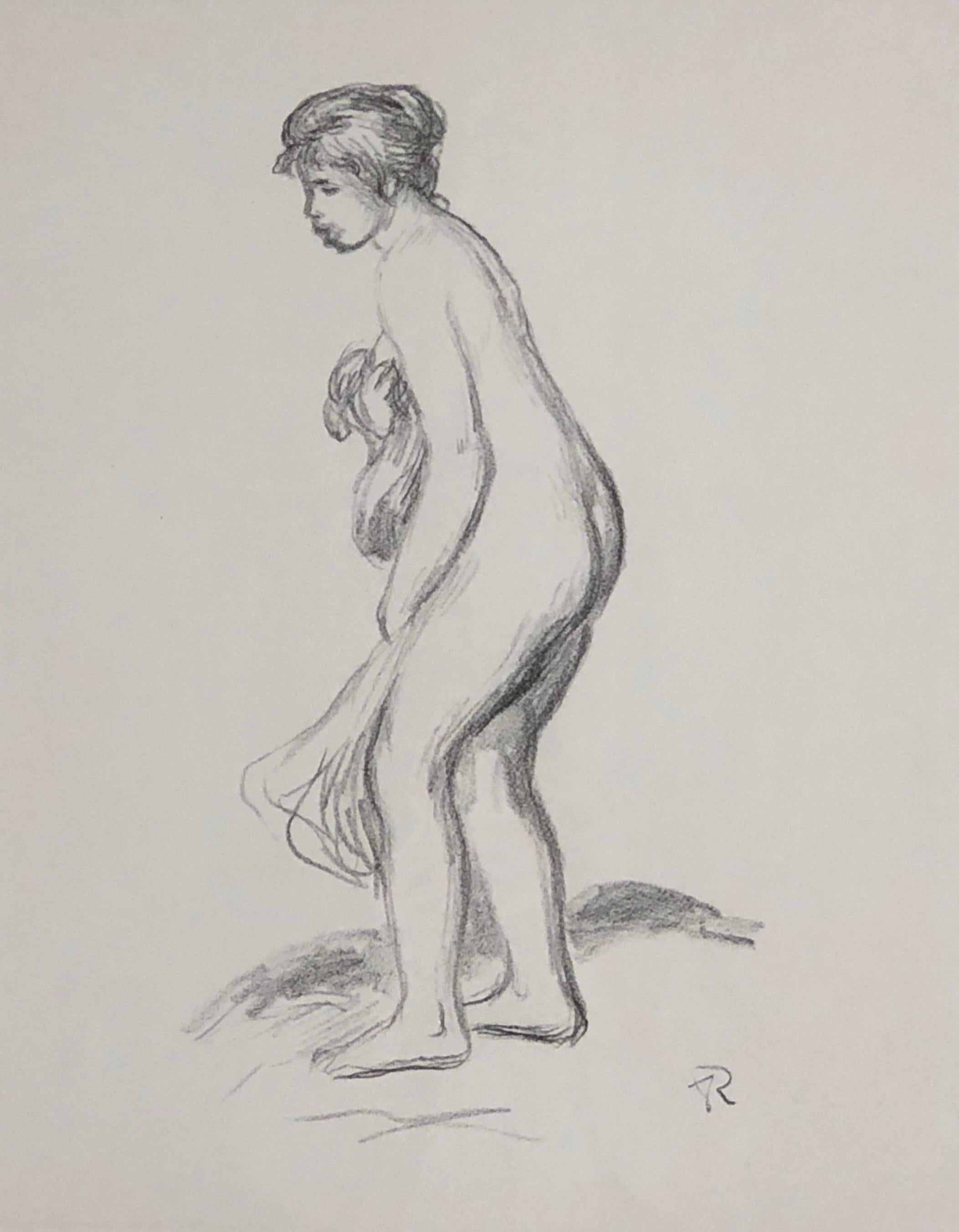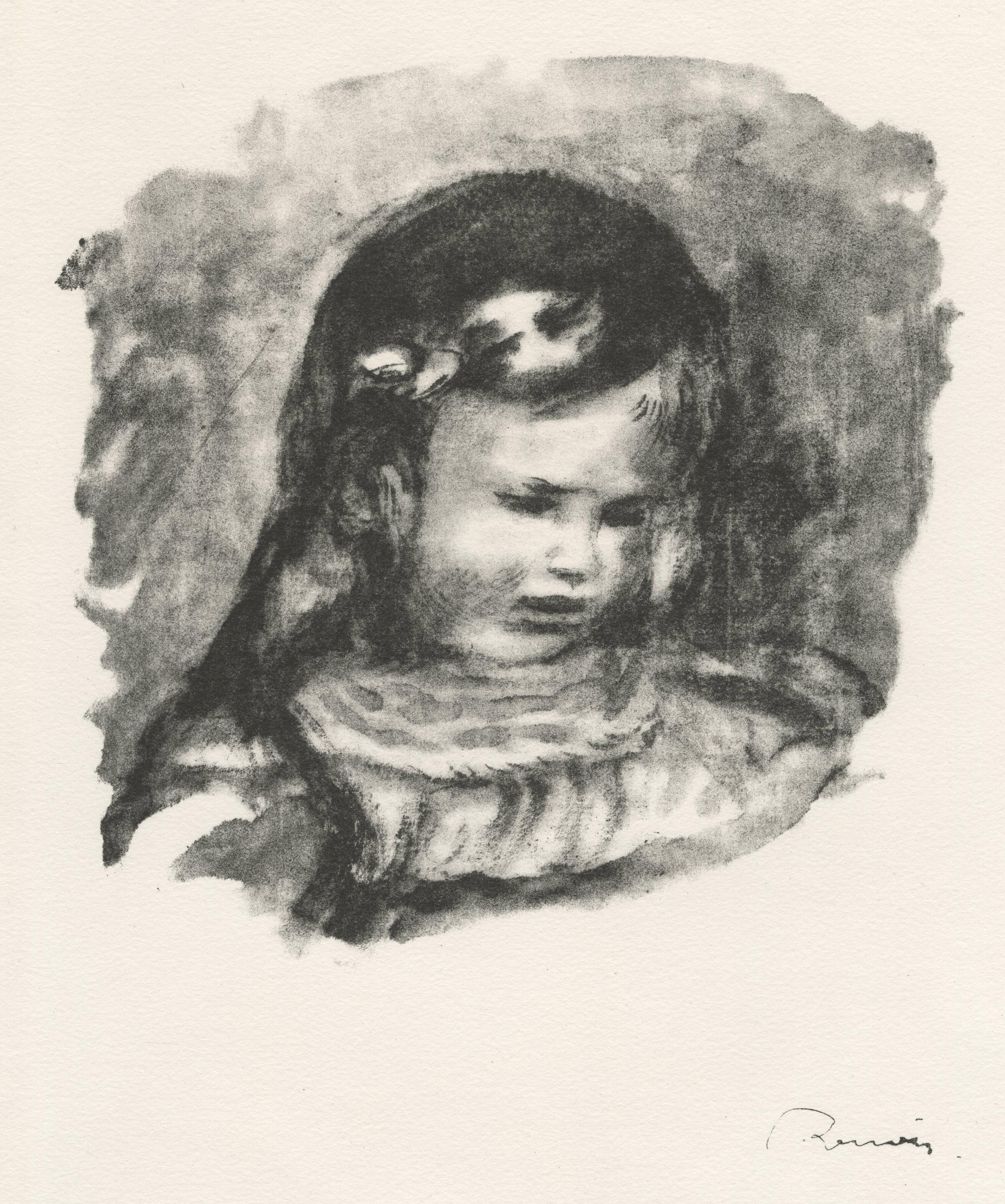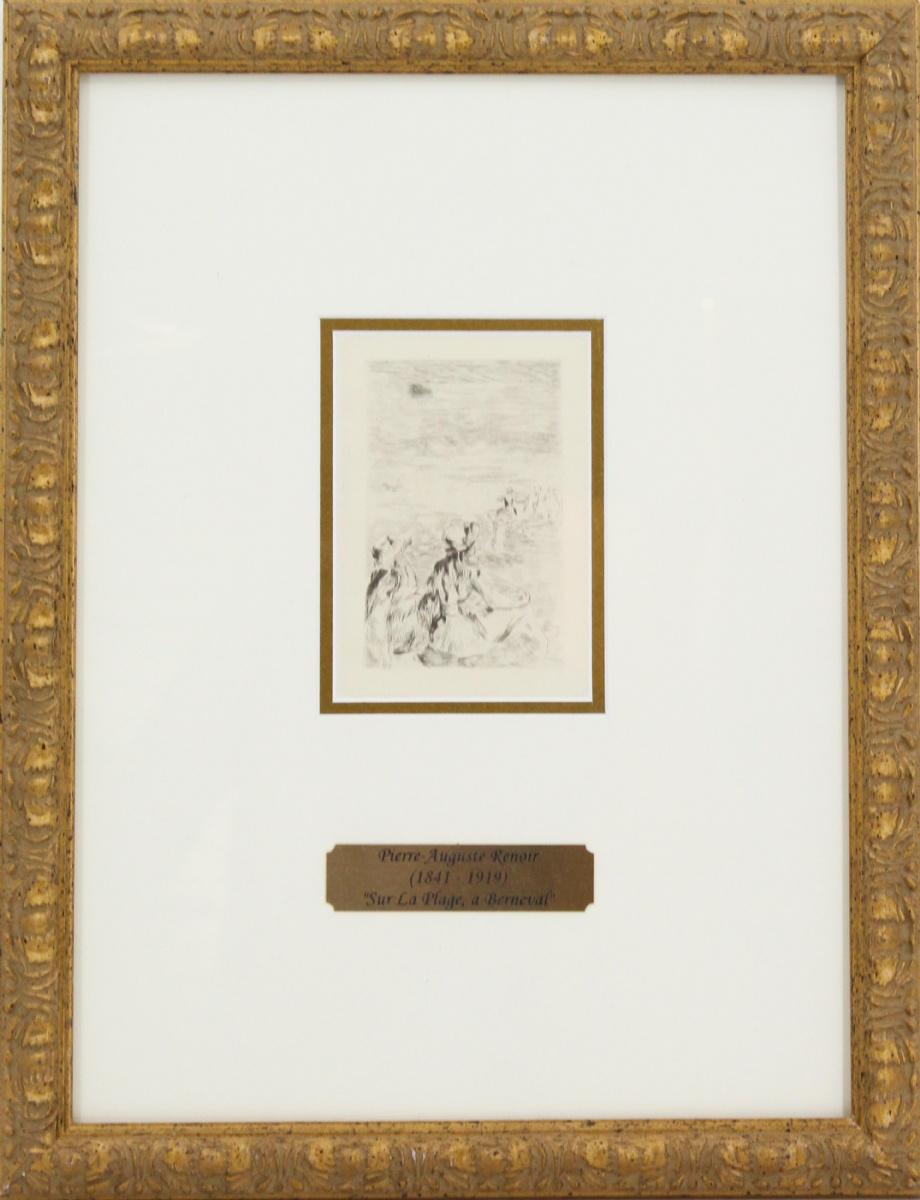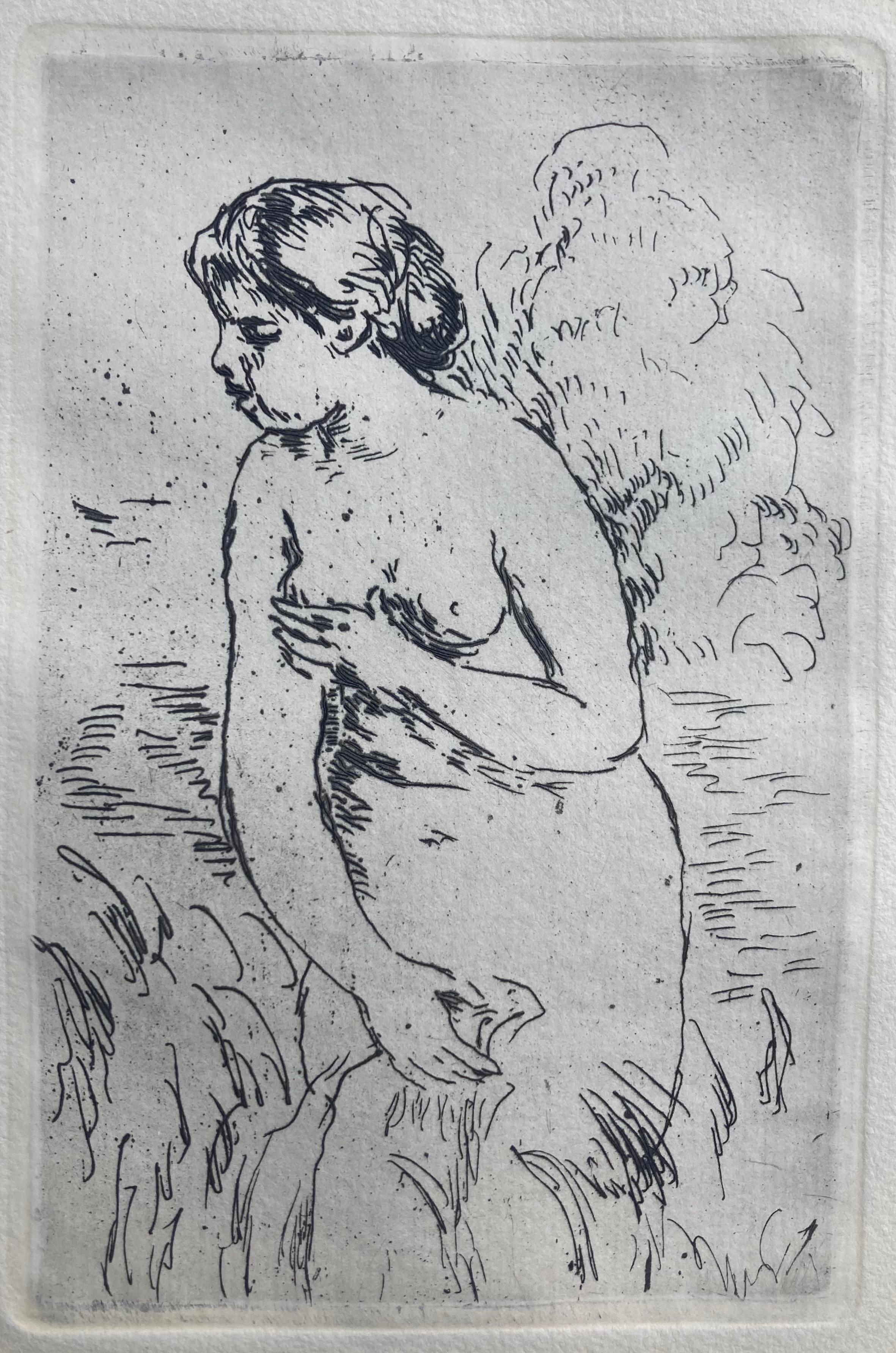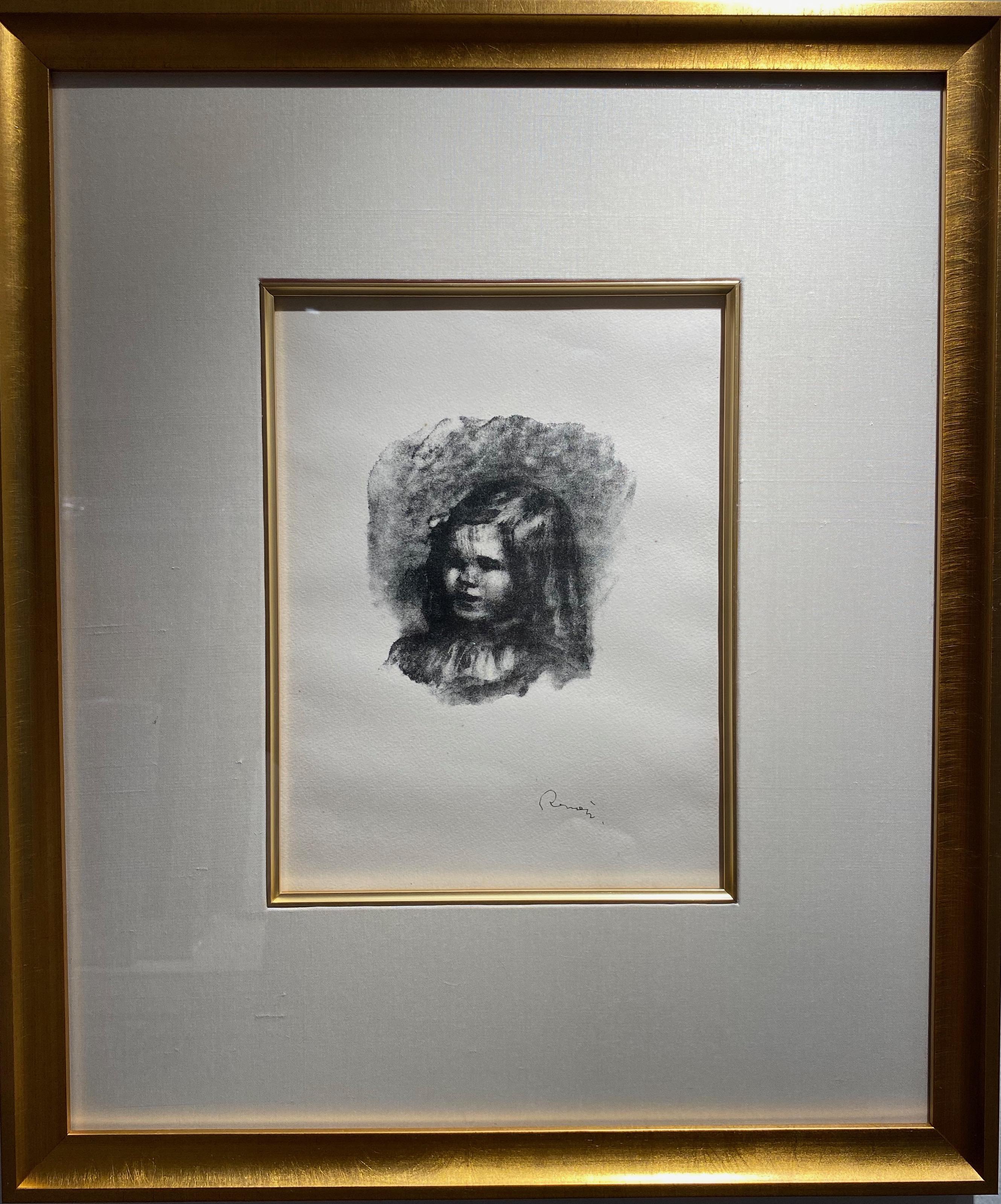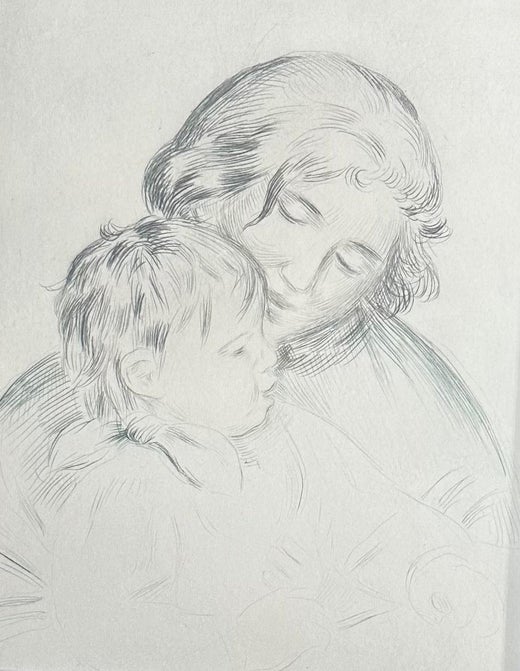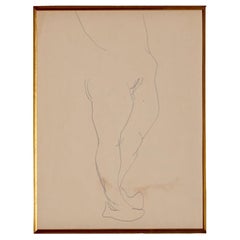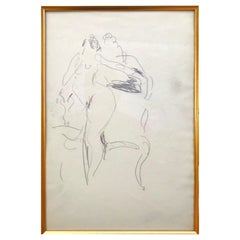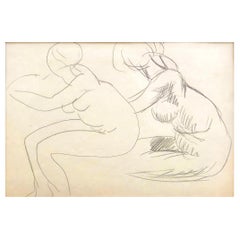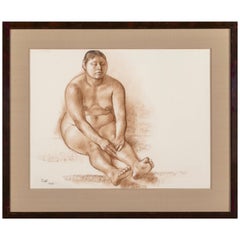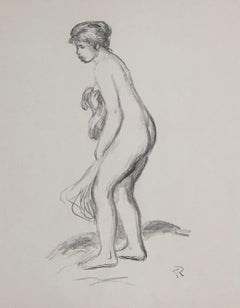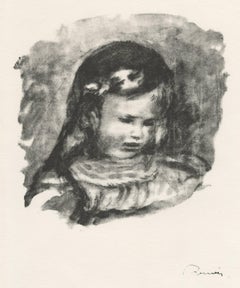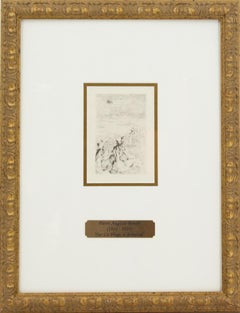Items Similar to Pierre Auguste Renoir Apres Le Bain Sanguine Study
Want more images or videos?
Request additional images or videos from the seller
1 of 24
Pierre Auguste RenoirPierre Auguste Renoir Apres Le Bain Sanguine Study1910
1910
$235,000
£179,929.61
€206,142.72
CA$335,335.75
A$367,019.29
CHF 190,778.43
MX$4,417,203.59
NOK 2,398,386.19
SEK 2,249,760.92
DKK 1,539,752.74
About the Item
Pierre-Auguste Renoir’s Apres Le Bain is a stunning 22 x 26-inch pencil and Sanguine chalk painting depicting a nude woman after her bath. This large, exquisitely detailed work showcases Renoir’s mastery of form and delicate use of forthought. Extremely rare and significant, it holds immense importance in the art market, embodying the Impressionist’s sensual and intimate style.
Pierre Auguste Renoir (French, 1841-1919)
Après le Bain, circa 1910
pencil and red sanguine chalk on tracing paper
Sheet: 26.5 x 21.75 Inches. (67.3 x 55.2cm)
Frame: 39 X 33.5 x 3 Inches
From the Collection of Sidney Rothberg, Philadelphia, Pennsylvania with an impeccable provenance.
Literature
The present work will be included in the forthcoming catalogue critique of Pierre-Auguste Renoir being prepared by the Wildenstein Institute established from the archives of François Daulte, Durand-Ruel, Venturi, Vollard and Wildenstein. It will be accompanied by a Letter of Inclusion from the Wildenstein Plattner Institute, Inc.
Provenance
The Artist.
To his son, Pierre Renoir.
To Madame Pierre Renoir, Paris (widow of the artist's son).
Sotheby's, London, sale of December 2, 1987, lot 447.
Acquired directly from the above sale.
Jeffrey Fuller Fine Art, Philadelphia.
Acquired directly from the above sale.
Mr. Rothberg had a distinct appreciation for studies that prepared for later, finished works. These drawings aligned with his particular collecting philosophy, which centered on uncovering an artist's creative process. He believed that drawings most clearly revealed the inner workings of an artist’s mind.
The current drawing fits seamlessly within this collecting vision. Created around 1910, it serves as a preparatory study for a painting of the same title (now held in a private collection) and exemplifies Renoir’s refined, modern style of the early 20th century. Executed in red chalk—a deliberate reference to an 18th-century technique—the piece features fluid curves and confident lines, evoking the influence of Rubens and Tintoretto, two masters whom Renoir deeply admired..
Condition Report
In overall Very Good condition. The tracing paper is toned, and entirely laid down to the support board via white paper tape along all four edges (underneath which we notice remnants of old brown tape). Lightly faded, with remnants of red chalk around the figure up top (likely due to some rubbing). Discolored outer edges (mostly covered when the work is framed). With minor folds along the outer edges, lightly brittled, due to the mounting. Restorations to edges, tears and notable on lower left and upper left corners (1/2 and 1.5 square inches) fine undulations on some edges visible on photos out of frame. Presents beautifully. Frame in good condition and fitting of work but can be changed to buyers tatste.
Pierre-Auguste Renoir (born February 25, 1841, Limoges, France—died December 3, 1919, Cagnes) was a French painter originally associated with the Impressionist movement. His early works were typically Impressionist snapshots of real life, full of sparkling color and light. By the mid-1880s, however, he had broken with the movement to apply a more disciplined, formal technique to portraits and figure paintings, particularly of women.
Renoir was born into a family of artisans. His father, a tailor who had seven children, moved with his family to Paris about 1845. Renoir demonstrated his gift at an early age. Quickly recognizing his talent, his parents apprenticed him, at age 13, to work in a porcelain factory, where he learned to decorate plates with bouquets of flowers. Shortly after that, he was painting fans and then cloth panels representing religious themes for missionaries to hang in their churches. His skill and the great pleasure he took in his work soon convinced him he should study painting in earnest. Having saved a little money, he decided, in 1862, to take evening courses in drawing and anatomy at the École des Beaux-Arts as well as painting lessons at the studio of Charles Gleyre, a Swiss painter who had been a student of the 19th-century Neoclassical painter Jean-Auguste-Dominque Ingres. Although the academic style of his teacher did not suit Renoir, he nevertheless accepted its discipline in order to acquire the elementary skills needed to become a painter.
The sitter is almost certainly Gabrielle Renard, the nanny to Renoir’s children and a frequent model for the artist. Gabrielle was the cousin of Renoir’s wife, Aline, and came to Montmartre to work for the family at the age of 16. She developed a strong bond with the family and became a favorite subject for Renoir, appearing in several of his most important works, including his 1911 Gabrielle with a Rose (Musée d'Orsay). When Renoir began to suffer from severe rheumatoid arthritis that would eventually leave him unable to walk and scarcely able to grasp a paintbrush, it was Gabrielle that would assist the artist by positioning the paintbrush between his crippled fingers.
Born in Limoges, France in 1841, Renoir began his career as an apprentice to a painter of porcelain wares. He later moved to Paris at the age of 21, enrolling at the prestigious École des Beaux-Arts. It was here, while studying under Charles Gleyre, that Renoir attained a tremendous appreciation for the academic style of painting, a quality that would last throughout his career. This was also when he met Claude Monet and several other classmates, with whom he would later form the Impressionists.
Working closely with Monet, Renoir began experimenting with the portrayal of light and its effect on his canvases. The youngest member of the Impressionist movement, an astute Renoir recognized how a subject was constantly changing due to the dynamic effects of light on color. Relying heavily upon his academic training that focused on composition, lines and descriptive details, Renoir distinguished himself among his contemporaries. His intuitive use of color and expansive brushstroke, along with acute attention to his subject, have placed him among the finest painters in history.
This work is accompanied by a certificate of authenticity and will be included in the forthcoming catalogue raisonné of the work of Pierre-Auguste Renoir from the Wildenstein Plattner Institute.
AVANTIQUES is dedicated to providing an exclusive curated collection of Fine Arts, Paintings, Bronzes, Asian treasures, Art Glass and Antiques. Our inventory represents time-tested investment quality items with everlasting decorative beauty. We look forward to your business and appreciate any reasonable offers. All of our curated items are vetted and guaranteed authentic and as described. Avantiques only deals in original antiques and never reproductions. We stand behind our treasures with a full money back return policy if the items are not as described.
- Creator:Pierre Auguste Renoir (1841 - 1919, French)
- Creation Year:1910
- Dimensions:Height: 39 in (99.06 cm)Width: 33.5 in (85.09 cm)Depth: 2.5 in (6.35 cm)
- Medium:
- Movement & Style:
- Period:
- Condition:
- Gallery Location:Dallas, TX
- Reference Number:1stDibs: LU2724216692002
Pierre Auguste Renoir
Pierre-Auguste Renoir had his first experience with art in 1845 at the age of 4 when his family moved to Paris from Limoges and settled near the Louvre. By the age of 13, he had begun to seriously study and practice his work. Renoir started as an apprentice painter in a porcelain factory, where he spent five years. He then took drawing lessons from Charles Gleyre and in 1862, when he was 21; Renoir attended the Ecole des Beaux-Arts. It was at the National School of Fine Arts in Paris where Renoir met the future founders of Impressionism, Claude Monet, Alfred Sisley, and Frederic Bazille. Renoir paintings remained in the traditional style during the 1860s. His portrait of his mistress, Lise Trehot, was traditional enough to be accepted for the 1867 Salon. Pierre Auguste Renoir’s paintings began to change shortly after he moved in with Claude Monet and Frederic Bazille in 1869. Renoir updated his technique and color scheme. Renoir painted mostly outdoors and began to use vibrant, pure colors and little brush strokes. Renoir, along with Claude Monet, Camille Pissarro, and Alfred Sisley was part of the first exhibition of the Society of Independent Artists in 1874. It was at this exhibit that the term “Impressionism” was first used. The term was coined by a French art critic who took the name from a Monet painting. The term was meant to be derogatory and the show was a financial failure. Despite the failure, the artists continue to exhibit together and were joined by Edgar Degas and Georges Seurat. By the early 1880s, the public had begun to recognize the importance of the Impressionists’ work. In the early 1880s, Renoir traveled and painted extensively. He held his first one-man exhibition in 1883 in Paris. He received commissions from prominent Parisians and painted numerous group portraits of his friends, writers, and fellow artists. By 1887, Renoir was famous and donated several paintings to Queen Victoria for her Golden Jubilee. By the time he was 50, Renoir’s health began to decline. He suffered from cataracts, rheumatoid arthritis, and ankyloses, and spent the last twenty years of his life confined to a wheelchair. During this time he continued to paint and even took up sculpting.
About the Seller
No Reviews Yet
Vetted Professional Seller
Every seller passes strict standards for authenticity and reliability
1stDibs seller since 2024
10 sales on 1stDibs
Typical response time: 10 hours
- ShippingRetrieving quote...Shipping from: Dallas, TX
- Return Policy
Authenticity Guarantee
In the unlikely event there’s an issue with an item’s authenticity, contact us within 1 year for a full refund. DetailsMoney-Back Guarantee
If your item is not as described, is damaged in transit, or does not arrive, contact us within 7 days for a full refund. Details24-Hour Cancellation
You have a 24-hour grace period in which to reconsider your purchase, with no questions asked.Vetted Professional Sellers
Our world-class sellers must adhere to strict standards for service and quality, maintaining the integrity of our listings.Price-Match Guarantee
If you find that a seller listed the same item for a lower price elsewhere, we’ll match it.Trusted Global Delivery
Our best-in-class carrier network provides specialized shipping options worldwide, including custom delivery.More From This Seller
View AllHenri Matisse Drawing Of A Nude Torso From Matisse Estate
By Henri Matisse
Located in Dallas, TX
Henri Matisse (French 1869-1954) Pencil Drawing Of A nude torso Catalogued as Number Z 542 in the Artist Archives Pencil on paper, c. 1900.
Sheet: 9 3/8 x 11 3/4 in.
Framed: 22...
Category
Early 1900s Aesthetic Movement Paintings
Materials
Paper
Henri Matisse Pencil Of Nude By Chair From Matisse Estate
By Henri Matisse
Located in Dallas, TX
Henri Matisse Original Pencil On Paper Study Of A Standing Nude Next To Chair
Pencil on paper
Unsigned.
Sheet: 8.85 x 13.75 Inches
Framed: 25....
Category
Early 1900s Modern Paintings
Materials
Paper
Henri Matisse Pencil Nude Etude From Matisse Estate
By Henri Matisse
Located in Dallas, TX
Henri Matisse Original Pencil On Paper Study Of A Nude
Pencil on paper
Unsigned.
Sheet: 8.85 x 13.75 Inches
Framed: 25.5 x 21.75 Inches
The ...
Category
Early 1900s Modern Drawings and Watercolor Paintings
Materials
Paper
Francisco Zuniga Original Pastel Nude Painting Catalogued
By Francisco Zúñiga
Located in Dallas, TX
Francisco Zúñiga (Mexican, 1912-1998) Seated nude with extended legs. This woman with eyes heavy in meditation shows a myriad of emotions including humility, vulnerability and fatigue. The figure makes the viewer appreciate those who do all the mundane and heavy lifting service work for us teaching us sympathy and empathy. Another very powerful work by Zuniga worthy of any art space.
Black and sepia Conté Crayons made from a blend of natural pigments, kaolin clay, and graphite on paper.
Signed and dated lower left: Zúñiga / 1975
Ariel Zúñiga personally confirmed the authenticity of this drawing when I acquired it. This painting will be included in his forthcoming Francisco Zúñiga: Catalogue Raisonné, Volume V.
Sheet Size: 19-5/8 x 25-1/2 inches (49.8 x 64.8 cm)
Framed Dimensions 28.5 X 34 Inches
Condition: Excellent original condition. Sheet hinged to mat; pinholes to the corner, inherent to the works creation. Original solid wood frame with wear and touch ups.
AVANTIQUES is dedicated to providing an exclusive curated collection of Fine Arts, Paintings, Bronzes, Asian treasures, Art Glass and Antiques. Our inventory represents time-tested investment quality items with everlasting decorative beauty. We look forward to your business and appreciate any reasonable offers. All of our curated items are vetted and guaranteed authentic and as described. Avantiques only deals in original antiques and never reproductions. We stand behind our treasures with a full money back return if the items are not as described.
José Jesús Francisco Zúñiga Chavarría (December 27, 1912 – August 9, 1998) was a Costa Rican-born Mexican artist, known both for his painting and his sculpture. Journalist Fernando González Gortázar lists Zúñiga as one of the 100 most notable Mexicans of the 20th century, while the Encyclopædia Britannica calls him "perhaps the best sculptor" of the Mexican political modern style.
Zúñiga was born in Guadalupe, Barrio de San José, Costa Rica on December 27, 1912 to Manuel Maria Zúñiga and María Chavarría, both sculptors. His father worked as a sculptor of religious figures, and in stone work. His artistic inclinations began early and by the age of twelve had already read books on the history of art, artistic anatomy and the life of various Renaissance painters. At age fifteen he began working in his father’s shop. This experience sensitized him to shape and spaces. In 1926 he enrolled in the Escuela de Bellas Artes in Mexico, but left the following year to continue on his own. As part of his self-study, he studied German Expressionism and the writings of Alexander Heilmayer, through which he learned of the work of two French sculptors, Aristide Maillol and Auguste Rodin, coming to appreciate the idea of subordinating technique to expression.
Zúñiga’s painting and sculpting work began receiving recognition in 1929. His first stone sculpture won second prize at the Exposición Nacional de Bellas Artes. In the following two years continued to win top prizes at this event. This work made critics recommend him for study abroad. He won first prize in a 1935 Latin American sculpture...
Category
1970s Modern Nude Paintings
Materials
Crayon
Maximilien Luce La Cueilleuse de Fruits
By Maximilien Luce
Located in Dallas, TX
Maximilien Luce
(French, 1858-1941)
La Cueilleuse de Fruits
oil on newsprint laid down to board
signed Luce (lower right)
Sight: 13 1/2 x 6 1/2 in. (34.3 x 16.5cm)
Frame: 17.5 x 10 I...
Category
1880s Expressionist Figurative Paintings
Materials
Oil, Newsprint
Anton Faistauer Nude, 1913
By Anton
Located in Dallas, TX
Anton Faistauer ( 1887-1930) Female Nude standing 1913
Black chalk on paper
Signed upper right and dated 1913,
Sheet: 18.9 X 13 Inches (48x33cm)
framed: 26.5 X 20.75
Provenance: Re...
Category
1910s Art Deco Nude Drawings and Watercolors
Materials
Paper
You May Also Like
Pierre- Auguste Renoir, "Woman Bathing, Standing, Full Length Profile", litho
By Pierre-Auguste Renoir
Located in Chatsworth, CA
This piece is an original lithograph created by Pierre- Auguste Renoir in 1896. This piece was done in black on Arches Ingres laid paper. There is also an edition of 100 impression...
Category
18th Century Figurative Prints
Materials
Lithograph
Claude Renoir, la Tete Baisee (Claude Renoir, Head Lowered)
By Pierre-Auguste Renoir
Located in Fairlawn, OH
Claude Renoir, la Tete Baisee
(Claude Renoir, Head Lowered)
Lithograph, 1904
Edition 1,000, this one of 950 on wove paper with the stamp signature (there were also 50 impressions pri...
Category
Early 1900s Impressionist Figurative Prints
Materials
Lithograph
Pierre-Auguste Renoir (1841-1919) - On the beach at Bernegal
By Pierre-Auguste Renoir
Located in Naples, Florida
Pierre-Auguste Renoir (1841-1919) - On the beach at Bernegal
Category
20th Century Landscape Paintings
Materials
Drypoint
Auguste Renoir"s last student: impressionist female nude the Statuesque Bather
By Lucien Boulier
Located in Norwich, GB
If something about this painting seems familiar, it is for good reason! Dating from circa 1905-10, it is a work by Lucien Boulier (1882-1963), who was effectively Renoir's last stude...
Category
Early 20th Century Impressionist Figurative Paintings
Materials
Canvas, Oil
Baigneuse debout à mi-jambes
By Pierre Auguste Renoir
Located in Santa Monica, CA
PIERRE-AUGUSTE RENOIR (French, 1841 - 1919)
BAIGNEUSE DEBOUT A MI JAMBES (D., S. 23)
Etching, 1910, a later impression on laid paper, the only state. Full margins with deckle edge...
Category
1910s Impressionist Figurative Prints
Materials
Etching
$760 Sale Price
20% Off
"Claude Renoir, tourné à gauche" (Claude Renoir, Turning Left) by Renoir
By Pierre-Auguste Renoir
Located in Hinsdale, IL
RENOIR, PIERRE AUGUSTE
(1841 - 1919)
Claude Renoir, tourné à gauche
Claude Renoir, Turning Left
Delteil 40, Stella 40
Original chalk lithograph ...
Category
Early 1900s Impressionist Portrait Prints
Materials
Etching
More Ways To Browse
Auguste Jean
Porcelain D Art Limoges France
The Nanny
Renoir Paintings
18th Century French Impressionist Paintings
Antique Limoges Plate With Flowers
Vintage Belly Dance
Water Floating Art
Wedding In Paintings
Wendy Artin
White Swan Paintings
William Frith
William Stewart
Alberto De Blobs
Alice And Martin Provensen
Alice Provensen
Basketball Painting
Beach Tent Vintage
